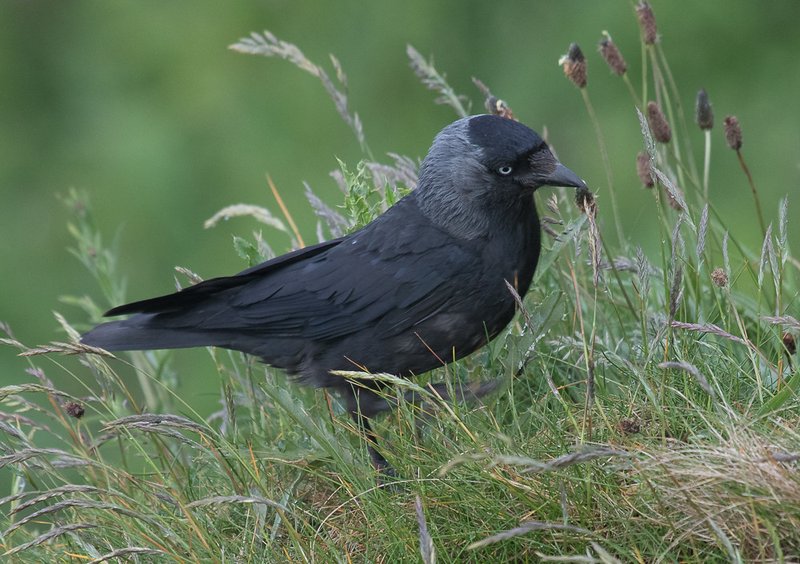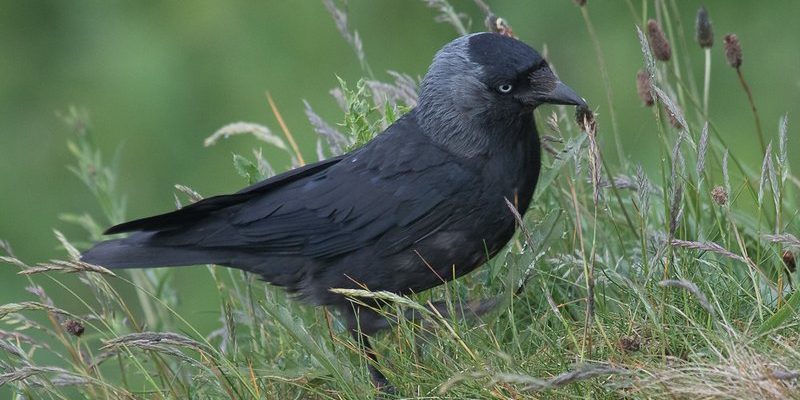
Have you ever spotted a sleek, black bird with a striking grey nape flying in flocks or perched on rooftops? That’s the jackdaw! These birds, part of the corvid family, are not only fascinating to watch but also incredibly intelligent. With their distinctive appearance and clever behaviors, jackdaws are a delight for birdwatchers and nature lovers alike.
Jackdaws are often found in various habitats across Europe, Asia, and North Africa. They have a unique blend of adaptability and social behavior, making them stand out in the bird world. Like all corvids, they showcase remarkable problem-solving abilities and complex communication skills. So, let’s dive into what makes these birds so intriguing!
Physical Characteristics
The jackdaw is easily recognizable. Adult jackdaws typically measure about 34-39 cm in length, making them one of the smaller members of the corvid family. They have a wingspan of around 67-75 cm, which is quite impressive for their size. Their feathers are predominantly shiny black, but they boast a distinctive pale grey neck, which adds to their charm.
One of the most striking features of the jackdaw is its eye. Their eyes are light-colored, almost pearly white, which stands out against their dark plumage. This strong contrast enhances their expressive nature, allowing for better social interactions within their flocks. The sharp, slightly hooked beak is another key characteristic that aids in their feeding habits.
| Size: | 34-39 cm in length |
| Wingspan: | 67-75 cm |
| Weight: | 250-350 grams |
| Color: | Black with grey neck |
| Lifespan: | Up to 15 years in the wild |
These birds are well-equipped for survival, with strong legs perfect for hopping and walking on various surfaces. Their physical features, combined with their intelligence, allow them to thrive in diverse environments.
Habitat and Distribution
Jackdaws are incredibly versatile in their choice of habitats. You might find them in urban areas, farmlands, forests, and even coastal regions. They prefer areas that offer a mix of open spaces and places to roost, such as trees, cliffs, and buildings. Their adaptability to human environments is one reason they are commonly seen in cities.
These birds are widespread across Europe, extending into parts of Asia and North Africa. In fact, they thrive in areas where they can forage for food while being close to their nesting sites. Jackdaws typically build their nests in tree hollows, cliff ledges, and even in chimneys or other structures created by humans.
In regions with harsh winters, jackdaws may migrate slightly to find milder conditions. However, many remain resident in their territories throughout the year. Their flexibility in adjusting to different environments showcases their resourcefulness as a species.
Diet and Feeding Habits
Jackdaws are omnivorous, which means they have a varied diet that includes insects, seeds, fruits, and even human food scraps. They are particularly fond of foraging in open fields and parks, where they search for seeds and insects. This scavenging approach allows them to take advantage of whatever food sources are available.
These clever birds have also been observed using tools to help them access food. For instance, they might drop hard-shelled nuts onto hard surfaces to crack them open. This is where their intelligence truly shines! Watching them strategize during foraging can be quite entertaining.
During the breeding season, their diet may shift slightly to include more protein-rich foods, which are essential for feeding their young. The flexibility in their diet helps ensure that they can thrive in various conditions, adapting to what is available in their environment.
Behavior and Social Structure
Jackdaws are highly social birds that often live in large groups, especially outside of the breeding season. Their flocks can be quite vocal, filled with chatters and caws that seem to communicate various messages. These calls are more than just noise; they play a key role in their social interactions and group dynamics.
Their social behavior doesn’t stop at their groups. Jackdaws are known to engage in playful activities, such as aerial acrobatics and games with each other. They are also excellent at recognizing individual faces, which aids in maintaining group cohesion. You might notice that they often pair up or form tight bonds within their flocks, further emphasizing their social nature.
During the mating season, jackdaws display courtship behaviors, including bowing and mutual grooming. After forming a pair bond, they will work together to build a nest and raise their young, showcasing their strong family ties.
Reproduction and Lifecycle
The breeding season for jackdaws typically runs from March to July. During this time, pairs will become increasingly active, fortifying their bonds and preparing their nests. The female usually lays between 3 to 6 eggs, which she incubates for about 17-19 days. The male assists in gathering food during this critical time.
Once the chicks hatch, they are dependent on their parents for food and protection. The young are fed a diet rich in protein to help them grow quickly. After about 4-5 weeks, the chicks fledge and leave the nest, but they often remain with their parents for several weeks as they learn to navigate their surroundings.
Jackdaw parents are attentive and protective, teaching their young essential skills for survival. The strong family bonds formed during this stage can last for years, as young jackdaws often help their parents with subsequent broods. This cooperative breeding behavior is a fascinating aspect of their lifecycle.
Conservation Status
Fortunately, jackdaws are currently listed as a species of least concern by the International Union for Conservation of Nature (IUCN). Their adaptability and intelligence have allowed them to thrive in a variety of environments, ensuring stable populations in many areas. However, like all wildlife, they face challenges such as habitat loss and changes in agricultural practices.
In urban environments, jackdaws often thrive alongside human developments. They are skilled at finding food sources in cities, whether it’s from parks or refuse bins. However, conservation efforts are still essential to ensure their habitats remain protected, especially in rural areas where farming practices may disrupt their nesting sites.
Awareness and appreciation of these intelligent birds can help promote their conservation. Engaging with local wildlife initiatives can make a difference in preserving the diverse ecosystems that support jackdaws and many other species.
Fun Facts About Jackdaws
- Jackdaws are known to have a playful nature, often engaging in games and aerial displays.
- They are highly intelligent and capable of solving complex problems.
- These birds can live for up to 15 years in the wild, and even longer in captivity.
- Jackdaws are among the few bird species known to recognize themselves in mirrors!
- Their social structure is highly complex, with strong familial and social ties.
FAQ
What does a jackdaw’s call sound like?
Jackdaws are quite vocal, and their calls are characterized by a series of caws and chattering sounds. You might hear them calling to each other while foraging or communicating within their flocks. Their vocalizations can vary depending on the situation, with softer calls during courtship and louder calls when alarmed.
Are jackdaws good at mimicking sounds?
Jackdaws are not as proficient at mimicking sounds as some other birds, like parrots. However, they can imitate certain noises they frequently hear in their environment. This can include human voices and other bird calls, particularly those of predators or other corvids. Their ability to adapt their sounds reflects their intelligence and social nature.
How can I identify a jackdaw from other corvids?
One of the easiest ways to identify a jackdaw is by its distinctive grey nape and pale eyes, which set it apart from other corvids like crows and ravens. Additionally, jackdaws are smaller and have a more slender build compared to their larger relatives. Observing their behavior in flocks can also give you clues, as jackdaws tend to be playful and sociable.
What do jackdaws eat in urban areas?
In urban environments, jackdaws often scavenge for human food. They are known to rummage through rubbish bins and find food scraps in parks. Their diet in cities can consist of leftover meals, seeds from bird feeders, and discarded fruits. Their adaptability means they can thrive wherever food sources are readily available.
Do jackdaws migrate?
While most jackdaws are resident birds, some may migrate short distances, especially in areas with harsh winters. They typically move to find milder conditions and more accessible food sources. However, many populations are quite sedentary, making their homes in the same areas year-round.
What is the lifespan of a jackdaw?
In the wild, jackdaws can live up to 15 years, although many may face challenges that shorten their lives. In captivity, with fewer threats and consistent food supplies, they can live even longer. Their longevity is often influenced by their environmental conditions and threats from predators.
Are jackdaws social birds?
Yes, jackdaws are known for their highly social nature. They often live in large flocks, especially outside the breeding season. Their social bonds are strong, and they engage in various communal activities. This social behavior helps them thrive in their environments and contributes to their problem-solving abilities.
How do jackdaws build their nests?
Jackdaws are resourceful when it comes to nest building. They often choose locations that are high up and sheltered, such as tree hollows, cliffs, or the eaves of buildings. Using twigs, grass, and various materials they find, jackdaws construct sturdy nests that provide safety for their young. Their choice of nesting sites reflects their adaptability.
What challenges do jackdaws face in their habitats?
Despite their current status as a species of least concern, jackdaws face challenges such as habitat loss due to urbanization and changes in agricultural practices. Additionally, they can be affected by climate change, which impacts food availability. Conservation efforts are crucial to ensure they can continue to thrive in their various environments.
Can jackdaws be kept as pets?
While jackdaws are incredibly intelligent and captivating birds, they are wild animals and not suitable as pets. Keeping a jackdaw would require specific permits, and they thrive best in their natural habitats with their social groups. Observing them in the wild allows people to appreciate their beauty and intelligence without compromising their well-being.
What are the most notable behaviors of jackdaws?
Jackdaws are known for their playful and intelligent behaviors. They engage in aerial displays, mimic sounds, and even play games with each other. Their social interactions include grooming and communicating through a variety of vocalizations. These behaviors highlight their complex social structures and problem-solving skills.

